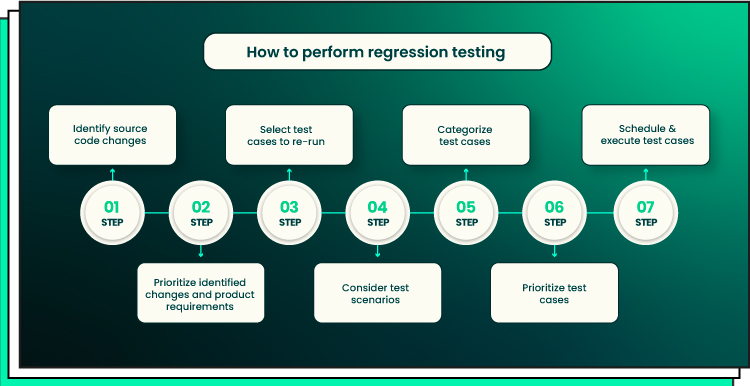If you plan to launch your first software development project, your team should know about regression testing. It is an indispensable part of the testing stage that helps you make sure that your product works as expected. Besides, such tests are organized when new features are added to the software, code is updated, or bugs are fixed.
In this article, we will uncover the notion of the regression test, providing you with the knowledge essential for the effective organization of this process. We will explore the best regression test techniques and discuss their role in ensuring that the software is always up and running and keeps pleasing users with bug-free work.
Regression Testing Meaning
Let’s start with the regression testing definition. This is the process of testing software after any changes to the code are made. This type of testing helps developers make sure that the improvements and code modifications do not cause bugs and issues.
Experienced project managers try to make software development dynamic and efficient by implementing agile software development practices. This approach allows for continual product development and improvement, which means new features are regularly added to the software. In this regard, regression tests play a very important role as they help the project team maintain high-quality software while not disrupting the CI/CD process.
Testing of this type can be conducted manually and automatically. When conducted manually, there is a high chance that the process will be more insightful. If we talk about manual testing, to ensure the correctness of the process, developers should create test scripts based on their work with the software. Then, they can use these cases to automate testing sessions and get the most informed results.
Today, developers and QA engineers can choose between numerous regression testing software tools to create test cases that will look for specific errors. After detecting bugs, the project team will also be able to trace the reason for them occurring and improve their coding practices to prevent such issues in the future. As you see from the regression testing meaning, this procedure is a must in cases of long-lasting and scaling projects if you want to keep your code clean and error-free.
How to Conduct the Regression Test: Top 5 Techniques
There exist 5 main testing techniques that are applied in the manual sessions. Let’s discuss their essence and application in more detail.
Progressive testing
Progressive testing presupposes that the new test cases are created in accordance with modifications and changes made to the code. This software regression testing technique enables a team to align the changes with the testing procedures they implement. By applying this testing type, the software development team makes sure that the features they work on will pass the checks and won’t be removed in the next iterations.
Thus, progressive testing helps keep testing and development in sync, preventing situations when a lot of time is spent on developing a feature, and the project team should remove it in the next iteration because it crashes the code. The drawback of this testing type is that it’s time-consuming and leads to an increasing volume of work hours on the project.
Retest-all regression technique
Retest all or retest everything is the technique of regression tests that involves retesting the code using all available test scripts. This type of testing helps software engineers get everything at once. By retesting the code, they make sure that it has no bugs or errors, and that the product can be safely deployed.
The benefit of this testing technique is that it gives the project team a complete picture of the code quality and state, enabling them to fix all the issues after conducting this comprehensive session. On the other hand, retest-all is a time-consuming approach that takes more effort compared to segmented testing sessions. This is why this testing type is usually applied only in cases when some significant changes or updates are added to the product. When we talk about minor modifications, there is no need to apply the retest-all technique and leverage all testing scripts in the session.
Corrective testing
Corrective testing can be leveraged as an additional measure to make sure that the software code is of high quality. Corrective testing involves running all test scripts and checking the code when no code changes are added. This type of testing also helps make sure that the test cases the project team created are practical and that they help effectively check the code.
So, the insights from regression testing in software development allow the project team to double-check if the software functions as expected, as well as validate the effectiveness of their test cases. Uncovering how their test cases work helps them develop a solid quality assurance strategy.
Test case prioritization
This testing method lies in prioritizing the test cases based on their importance and impact on the code quality. In other words, test case prioritization involves choosing the test scripts that should be used first based on specific criteria. For example, the impact on security or users, failure rate, etc. The priorities are defined differently in each case, depending on the business situation and the current goals a company sets.
How to know what test scripts to prioritize in your case? For this, you will have to conduct an analysis of your business needs and the aspects of software that have the biggest impact on your performance.
Forbytes can conduct a deep analysis of your business problems and develop effective tech-driven solutions, be it the aspect of quality assurance or building software from scratch. Contact us to talk about your project.
Test selection
Test selection is choosing and running only some scripts of software regression testing. To make the choice, the QA team defines the aspects of the software that are most likely to be impacted by the code modifications. This testing method is used in cases when a team creates feature-rich and complex software and testing it completely is unnecessary and will take a lot of time.
The drawback of this approach lies in the fact that, still, the project team may later find out that the code changes affected some unexpected aspects of software that were not tested. To prevent this from happening, test selection should be applied only at extra QA phases and finished with full-scale tests.
Regression Testing Software Tools: What to Choose
Regression testing software helps QA engineers effectively organize and conduct the testing process. Let’s look at the most popular tools implemented by software development companies, including ours.
Tricentis Tosca
This end-to-end testing platform is powered by Vision AI and allows QA engineers to run different testing types, including regression testing. With its help, your team can automate testing, create their own test cases, and make use of the rich feature set. Anyone can leverage this model-based tool for test automation since it’s codeless and intuitive.
The tool supports more than 160 technologies, enabling us to test all aspects of software, including APIs, user interface, data layer, etc. One more benefit of this tool is that it is suitable for complex IT solutions, such as extensive mobile, web, and enterprise applications.
Cucumber
This is one of the behavior-driven testing solutions that streamline the cooperation between QA engineers, software developers, and non-technical project representatives. To write test scripts, the plain English language is used, meaning almost anyone can use the tool. The benefits of using this software include the feature of reusing steps, which makes the testing process more efficient.
However, this testing tool suits best for big projects. For smaller ones, it may lead to unnecessary complexities.
SoapUI
SoapUI is the functional tool frequently used for load and regression tests. It’s used to test REST, GraphQL APIs, and SOAP protocols. With its help, you can create test cases, run end-to-end testing efficiently, and integrate your tests with third-party solutions.
A significant benefit of this tool is that it’s open source, meaning anyone can try testing the software with SoapUI. Besides, the tool is used in small to big projects and has a wide open-source community.
Postman
Like SoapUI, Postman is also the solution used for API and web service testing. It allows testers to perform both manual and automated regression tests.
Postman has the potential to streamline your API lifecycle and facilitate collaboration within your team. It comprises a comprehensive set of API testing tools and provides an API repository that can be used by businesses to store, manage, and maintain their API artifacts.
Appium
If you are creating a mobile application, Appium can be the testing tool you need. Appium is used for the regression test of mobile applications written in various languages, including JavaScript, Java, Ruby, Python, etc. You can test both iOS and Android applications with Apium.
Testers use this tool to mimic the real conditions of the post-release app’s functioning to check if it works as expected. It is designed to streamline UI automation, unifying diverse automation technologies under one roof.
Apache JMeter
Apache JMeter is a digital testing tool designed for Java. With its help, you can conduct performance, load, and functional testing of web apps. The tool is not designed specifically for regression testing. However, you can use it to mimic website load and test the performance of your solution, which is one of the fundamental requirements of effective testing.
The tool works on the protocol level but looks like a browser. On their official website, you will find a lot of tutorials explaining how to conduct different testing types, record tests, extend the software, and more.
Jenkins
Jenkins is one of the most frequently used tools on the projects we execute. This popular testing solution is open source and helps our team automate testing.
We can conduct automated testing with its help and configure it so that Jenkins automatically launches the regression test whenever the code changes are introduced. Besides, Jenkins is frequently used to implement effective DevOps practices at Forbytes.
JUnit
JUnit is a testing framework for Java apps used primarily for unit testing. However, you can also conduct regression tests with this tool. QA engineers can create and run test scripts with JUnit in the Java environment. As the Java language evolves, JUnit also improves with new features and tools.
Selenium
This testing tool is one of the most popular open-source solutions on the market. It’s used for testing web apps written in different languages, such as C#, Python, Java, etc. With Selenium, QA engineers can simulate user behavior and check how the software performs under different traffic volumes. The tool is used for both regression and functional testing and has many benefits. One of the greatest ones is the wide coverage of operating systems and browsers it supports.
TestNG
TestNG is a data-driven framework inspired by JUnit and designed for Java. Compared to JUnit, TestNG is better and more effective, particularly when it comes to integrated class testing. TestNG is used to run a wide range of testing scenarios, including regression testing. It provides QA engineers with the chance to run parallel tests, use advanced annotations, etc.
How to Effectively Organize Regression Tests?
There is a common misconception that code testing is the pre-launch stage that typically finishes the project. However, under the agile methodologies, testing can be run in parallel with the development process, ensuring that no critical issues occur before the very release.
In this article, we’ve acquainted you with the notion of the regression test. As a business that plans to launch a software development project, you should be aware of the importance and steps of quality assurance. Knowing the basics of this testing type will help you organize the QA process effectively.
Yet, thorough testing is impossible without an experienced QA team who will maintain the code quality, reducing the time you will have to spend on fixing app bugs. Forbytes is a team of dedicated software developers, QA engineers, project managers, UI/UX designers, and other experts. Refer to us anytime when you need help with software integration, development, or testing.

Our Engineers
Can Help
Are you ready to discover all benefits of running a business in the digital era?

Our Engineers
Can Help
Are you ready to discover all benefits of running a business in the digital era?










